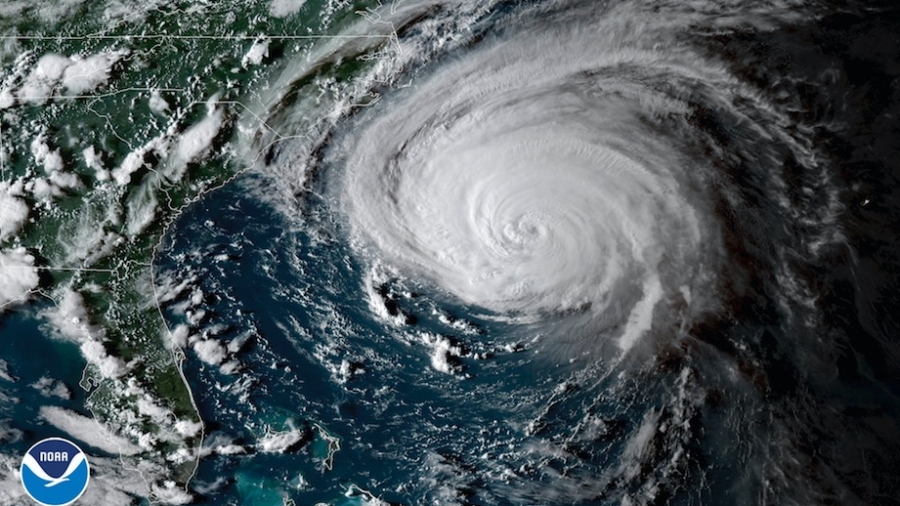Hurricane Florence has made landfall in North Carolina, forcing a life-threatening storm surge of floodwater inland and shredding structures in its path.
More than 60 people had to be pulled from a collapsing motel at the height of the storm, and many more who defied evacuation orders were hoping to be rescued.
Florence made landfall as a Category 1 hurricane at 7:15 a.m. at Wrightsville Beach, a few miles east of Wilmington, as the center of its eye moved onshore, the National Hurricane Center said.
“I see a biblical proportion flood event that’s going to occur,” Wilmington Police Chief Ralph Evangelous told ABC News. “I see the beach communities being inundated with water and destruction that will be pretty, pretty epic in nature.”

The storm’s maximum sustained winds held at about 90 mph, and it appeared that the north side of the eye was the most dangerous place to be as Florence moved ashore.
A gust of 105 mph was recorded at Wilmington airport, surpassing the power of Hurricane Fran two decades ago.
More Than 415,000 Power Outages
Coastal streets flowed with frothy ocean water, and more than 415,000 homes and businesses were without power, mostly in North Carolina, according to poweroutage.us, which tracks the nation’s electrical grid.
Authorities in the coastal city of New Bern, North Carolina, were working with responders to rescue at least 150 residents who reported being stranded in the hurricane’s surge, according to The Weather Channel.
Currently ~150 awaiting rescue in New Bern. We have 2 out-of-state FEMA teams here for swift water rescue. More are on the way to help us. WE ARE COMING TO GET YOU. You may need to move up to the second story, or to your attic, but WE ARE COMING TO GET YOU. #FlorenceNC
— City of New Bern (@CityofNewBern) September 14, 2018
Nearly 200 people have already been rescued, according to Colleen Roberts, a city public information officer, Fox News reported.
Craven County spokeswoman Amber Parker told ABC News that some people were trapped on their roofs. “I would say certain areas of New Bern are very desperate,” ABC reported.
New Bern was one of the first cities affected by storm surge floodwaters after the Neuse River overflowed, flooding parts of the town. A gauge on the river had already recorded 10 feet of inundation, the National Hurricane Center (NHC) said.

Reports have been received of major structural damage to homes and businesses in Onslow Country, according to The Weather Channel.
Over 20 inches of rain had fallen on Emerald Isle and Atlantic Beach, both in Carteret County, by Friday morning.
Hurricane Florence is set to inundate almost all of North Carolina in several feet of water, State Governor Roy Cooper told a news conference, while National Weather Service forecaster Brandon Locklear predicted up to eight months’ worth of rain in two or three days.
The hurricane was expected to make landfall near Cape Fear, North Carolina, at midday, and forecasters said its size meant it could batter the U.S. east coast with hurricane-force winds for nearly a full day.

Utility companies said millions were expected to lose power and its restoration could take weeks.
Key Warnings from NHC
“A life-threatening storm surge is already occurring along portions of the North Carolina coast and will continue through today and tonight,” the NHC said in an alert posted at 5 a.m. EDT on Friday, Sept. 14.
“This surge is also likely along portions of the South Carolina coast,” the warning continues.
“The greatest storm surge inundation is expected between Cape Fear and Cape Hatteras, including the Neuse and Pamlico Rivers and western Pamlico Sound.”
The NHC also warns of “life-threatening, catastrophic flash flooding and prolonged significant river flooding” through early next week.
“Damaging hurricane-force winds are occurring along portions of the North Carolina coast and are expected to spread to portions of the South Carolina coast” later on Friday.
The alert also cautions against the presence of large swells affecting Bermuda, portions of the U.S. east coast, and the northwestern and central Bahamas, “resulting in life-threatening surf and rip currents.”

Florence was downgraded to a Category 1 hurricane on Thursday evening with peak winds of 90 mph. Its center was moving west at only 6 mph and about 50 miles south of Morehead City at around 1 a.m.
About 10 million people could be affected by the storm and more than a million were ordered to evacuate the coasts of the Carolinas and Virginia, jamming westbound roads and highways for miles.
Roads and intersections on North Carolina’s Outer Banks barrier islands were inundated.
At least 12,000 people have taken refuge in 126 emergency shelters, Cooper said, with more facilities being opened.

The NHC said the threat of tornadoes was increasing as Florence neared shore and South Carolina Governor Henry McMaster said the heavy rain could trigger landslides in the west of his state.
NHC Director Ken Graham said on Facebook the storm surges could push as far as 2 miles inland. Heavy rains were forecast to extend into the Appalachian Mountains, affecting parts of Alabama, Tennessee, Kentucky, and West Virginia.
Emergency declarations were in force in Georgia, South and North Carolina, Virginia, Maryland, and the District of Columbia.
Reuters contributed to this report.


